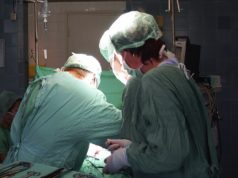
“We are at the beginning of a type A dissection revolution,” Joseph E Bavaria (University of Pennsylvania, Philadelphia, USA) told attendees at London Aorta 2021 (16–17 September, London, UK). In a keynote lecture, Bavaria charted the history of type A dissection management—from the Crawford era to the present day—and outlined what is to come. He stressed that global collaboration, good data and honest reporting of outcomes will be key to harnessing new technologies and techniques in the upcoming decade and beyond.
Opening his lecture, Bavaria referenced a Japanese study that highlighted the importance of bettering type A dissection management. He précised that everybody who died in the emergency room in one state in Japan got a computed tomography (CT) scan autopsy, which revealed that 8.1% of all deaths resulted from type A dissection, leading Bavaria to remark that the condition “is probably a lot more prevalent than we think”.
The Crawford era: “Nothing was certain”
In the 1990s, type A dissection management was in the [Stanley] Crawford era, Bavaria detailed. “When I looked at the Stanford data, as well as our own data from [the University of Pennsylvania], we reported a 25% mortality rate and a 25% stroke rate for type A dissection,” he said.
The presenter explained that the Crawford era of type A dissection management was defined by clamping the ascending aorta and only entering the arch if there was a visible tear that extended to the clamp. This technique “really was a disaster, but it was the best for that time,” Bavaria summarised. “Nothing was certain, it was intraoperative chaos and the bottom line was a lot of death and destruction,” he added, noting that there was no understanding of resuspension or proper indication for root surgery in type A dissection.
In addition to the high mortality rate associated with the procedure, Bavaria also noted a 4% mortality rate between admission to the hospital and admission to the operating room. “The result was a 30% mortality and stroke rate across the world at this time—the 30/30 club.”
The classic phase: Optimisation of circulation management
In the mid- to late-1990s, the cardioaortic surgical community designed a “therapeutic operation” for type A dissection, Bavaria told the London Aorta audience, which was intended to address the issues causing death in the first two weeks.
The speaker explained what was involved in the classic operation at the arch: “We did a hemiarch and then we placed neomedia to obliterate the distal false lumen. We used advanced circulatory adjuncts instead of just straight circulatory arrest alone.”
Optimisation at this time revolved around understanding the key concept regarding circulation management of the open aortic arch, Bavaria relayed. He elaborated: “The morbidity and mortality of short arch reconstructive times, less than 30 minutes or so, is an embolic phenomenon. The morbidity and mortality of a longer arch reconstructive time, say greater than 35 minutes, is a global neurological deficit and this is what applies to a type A dissection. This actually changed our practices at that time, when we started using an antegrade cerebral perfusion for the majority of dissections.”
New millennium sees focus on the aortic root
The next phase of type A dissection management history, which saw a shift in focus towards the aortic root, can be dated to the mid- to late-2000s, Bavaria told the audience.
“The type A dissection arch consensus at the time was that an open distal aortic arch procedure was basically standard of care. The single-clamped anastomosis was simply not appropriate,” he explained. “But what about the root?” he asked, rhetorically, answering that aortic valve insufficiency in these cases, for the most part, is related to the dissection at the aortic root. “Resuspension and aggressive reconstruction of the valve can be done in many, many cases”.
Ascending aortic cannulation “safe and effective”
Bavaria then turned to the future of type A dissection management, which, he believes, will revolve around four areas: central aortic cannulation, the root, a distal aortic solution and an endoaortic solution.
Regarding cannulation, the speaker made it clear that “there is no perfect place to cannulate in a type A dissection”. He communicated that his group at the University of Pennsylvania has adopted the central aortic cannulation first strategy, with 95+% of their patients receiving central cannulation. Bavaria also referenced a study by Thomas G Gleason et al at the University of Pittsburgh (Pittsburgh, USA), which found that, in 264 consecutive cases, central aortic cannulation reduced incision to bypass time by half.
“The bottom line of this is that ascending aortic cannulation is safe and effective and is no worse than axillary or femoral cannulation and has a lot of benefits, especially with regard to opening up the true lumen right away,” Bavaria commented.
Reoperation at the root should be minimised
“We must design operations at the root so that the reoperation at the aortic root is minimised,” Bavaria urged, highlighting that native valve retention during type A dissection is safe, works well and is “definitely part of [the University of Pennsylvania’s] future approach,” noting a 91% freedom from reoperation at 10 years of the root with a “robust” neomedia/resuspension technique.
“The goal [at the root] is to retain our native valves when possible. We can address the root aggressively, we do root procedures in the appropriate cases, otherwise repair of the root and valve and get good results”.
Distal aortic solutions “the most important part”
“Acute DeBakey type I dissection is a total aortic catastrophe,” Bavaria stated, adding that “we must address this issue if we are going to improve outcomes.” Thoracic endovascular aortic repair (TEVAR)-enabling solutions will be the answer, the presenter believes, who sees the future of aortic arch treatment as a competition between two different concepts: the frozen elephant trunk (FET) and the zone 2 arch with sequential branch TEVAR completion. He sees a number of advantages to the latter: “It is a simpler distal anastomosis, it can address most complex arch tears and eliminate the flap in the proximal head vessels. It is a much shorter operation, a much easier operation, […] it allows all definitive TEVAR options, there is less risk of recurrent nerve injuries, and it is not doing an unnecessary distal procedure at an index operation when it is not necessary.”
In short, the revolution in this area will be the creation and design of an index operation based on the availability of new technology, according to Bavaria.
“The future based on our data and our increased sophistication with the available technology, is that we really have a tripartite algorithm,” Bavaria relayed, noting that this is now the approach at the University of Pennsylvania. “In patients with a less than 10 or 15-year life expectancy, say greater than 65 or 70 who have a type A dissection, every one of those patients gets a classic hemiarch, for the most part. In patients with a primary arch tear or a distal malperfusion, which is about 20–25% of the patients, they will get a frozen elephant trunk. But everybody else, which is a lot of patients, and in patients less than 65 who are relatively stable in the sense they do not have a malperfusion, they get a zone 2 arch with a sequential branched graft TEVAR, for which we anticipate approval in the USA soon.”
Towards an endo solution
“Type A dissection and its treatment is the holy grail,” Bavaria said, noting, however, that it is a “hostile” territory for TEVAR. “We have new devices and new trials going on right now,” he relayed, referencing in particular the ARISE early feasibility investigational device exemption (IDE) trial looking at a Gore ascending endograft. In addition, Bavaria predicted that, in the future, “we are all going to be doing all type A dissections in a hybrid operating room”.
Aside from technological advancements, Bavaria also noted that an audit function is key as the cardioaortic community is “going to be doing lots of new stuff in the proximal aorta, across the globe”. This will require honesty, he stressed, suggesting that institutionalised databases, preferably at the level of the professional societies, are needed.
Key factors: Good data, better outcomes, honest reporting
While the revolution in type A dissection will encompass central aortic cannulation, a focus on the root and endovascular solutions, Bavaria forecasts that the next decade will be mostly about distal aortic solutions. “Index proximal operations will be driven and conceived by the availability of new technology endografts, zone 0, 1, and 2 TEVAR branched arch grafts, proximalisation of the conduct of operation will continue to reduce nerve injury and solutions that are collateral network friendly to decrease spinal cord ischaemia. All of these must enable TEVAR completion,” he remarked.
While it is “too early to have guidelines on type A dissection repair and aortic arch surgery,” Bavaria said, due to the “dynamic” nature of the condition, he ended by stressing what are the key factors necessary to making the most of the upcoming revolutionary era in type A dissection: “We need good data, we need better outcomes, and we have to be honest with our reporting.”













